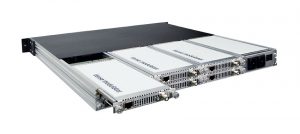
After more than 40 years of operation, DTVE is closing its doors and our website will no longer be updated daily. Thank you for all of your support.
Speed Merchants
 Broadband providers are engaged in an arms race to deliver ultra-fast services to subscribers. HFC cable network operators are making use of a fast-evolving range of tools to stay ahead of rivals, writes Adrian Pennington.
Broadband providers are engaged in an arms race to deliver ultra-fast services to subscribers. HFC cable network operators are making use of a fast-evolving range of tools to stay ahead of rivals, writes Adrian Pennington.
The ‘need for speed’ is dominating the cable operator market as competitors jostle to deliver tomorrow’s Gigabit services for consumer and commercial applications.
In order to deal with the expected rapid growth in demand for bandwidth, operators are searching for new technologies and architectures that can help them supply those speeds and new services, using an efficient scalable design, with predictable and controllable cost of ownership. In doing so, they may consider making changes to their headend network, nodes and amplifiers, their service groups sizes, the modulation profile used on different areas of the plant and more. The challenge is to choose the right mix of adjustments that can help them optimise their network and supply their subscribers’ demand.
“The evolution of the headend and the Converged Cable Access Platform (CCAP) is a major part of everyone’s roadmap for transformation,” says Sean Welch, VP and GM at Cisco’s service provider business.
Most operators have already embraced CCAP and are deploying DOCSIS 3.1 cable modems to enable DOCSIS 3.1 in most service areas. But DOCSIS 3.1 also opened up the possibility for 10G / 4096-QAM services along with a migration from a centralised to a Distributed Access Architecture (DDA). Each cable operator’s roadmap is unique of course, yet all need to begin with some form of digital transformation in their access.
Distributed, virtualised architectures are expected to transform cable networks. According to analyst group Dell’Oro, investment in cable infrastructure will reach US$2 billion (e1.8 billion) globally by 2023 to prepare operators for multi-gigabit future services using a combination of extended spectrum DOCSIS, full duplex DOCSIS 3.1 (FDX) and fibre-to-the-home (FTTH).
“Transitioning from where we are today into a Distributed Access Architecture is a real accomplishment,” says Welch. “Understanding that there is more than one way to get there is important.”
The overall aim is “to make networks more efficient, offer premium bandwidth, and stay ahead of fibre-based competitors,” Dell’Oro research director Jeff Heynen adds.
Priority investments
Broadly, it appears that operators in Europe are focusing their investment in three high-priority areas. The first is low latency DOCSIS for improved gaming support, virtual and augmented reality support and 5G backhaul support. Second is augmented upstream bandwidth capacity, which looks to support higher bandwidth demands in the upstream for video-based IoT devices.
Lastly is augmented downstream capacity, with a focus on supporting higher service level agreements for the future.
“Operators have many options available to them as they plan for the evolution of their future networks,” says Tom Cloonan, formerly of Arris and now office of the CTO, CommScope. “This includes turning on more DOCSIS 3.1 Downstream OFDM channels, plus beginning to turn on – and adding in additional – DOCSIS 3.1 Upstream OFDMA channels.”
Operators are also increasing the average bandwidth capacity to each of their subscribers by using combinations of at least three techniques. These are: increasing the spectral efficiency using the higher QAM Modulation orders permitted by DOCSIS 3.1; increasing channels per Service Group; and decreasing the number of subscribers per service group by performing physical or virtual node splits.
The Society of Cable Telecommunications Engineers & International Society of Broadband Experts (SCTE, ISBE), agrees that most upgrades in Europe are focused on increasing the capacity of the Hybrid Fibre-Coaxial (HFC) network, starting by migrating to DOCSIS 3.1 and then utilising node splits when necessary.
While still deploying and upgrading their heavy base of Integrated-CCAP systems, many operators are also considering transitions to DDAs where parts of the traditional I-CCAP are moved to the node structure – closer to the subscriber. Remote PHY or Remote MACPHY are the key technologies.
“Based on our discussions with European operators and ecosystem partners, it is clear that scaling capacity – with DOCSIS 3.1 – in both the upstream and downstream is a priority for 2019,” says Welch.
“DAA, and in particular Remote PHY, is a 2019 initiative driven by the need to modernise the analogue optical network that connect hub sites to fibre nodes in the field. Further, deploying IP over fibre in the aggregation network will unleash a compelling opportunity to converge all forms of access traffic – such as mobile, cable, fibre and copper – and operators are excited about this business case.”
DDA based on R-PHY
Based on discussions with operators it is working with, Finnish tech company Teleste says DDA “seems to offer the next attractive option to enable significantly higher data transmission capacity, attractive quality of service for subscribers, as well as less operational expense”.
“Nearly all operators that we are working with are at least investigating DAA technologies,” says Jim Walsh, marketing manager at California-based network test, measurement and assurance vendor Viavi Solutions. “The current status varies from initial investigations to full implementation; in many cases, their deployment pace is being dictated by the maturity of their selected solutions. Some operators see DAA as a long-term enabler of node splits to address bandwidth needs while also enabling virtualisation of their service provision infrastructure, while others see it as more of a short/medium term stopgap solution with FTTH as the inevitable long-term path.”
Early trials and limited deployments have begun, with CommScope projecting growth in the penetration of these technologies starting significantly by end of the year.
This is something also tracked by Dell’Oro, which expects North American cable operators – such as Comcast and Mediacom – to move from lab and field trials of R-PHY and R-MACPHY to general availability.
“Equipment vendors are ramping up production of their node units to meet what is expected to be a major year of deployments in 2019,” the analyst states in a briefing note. “We expect Comcast to use DDA to dramatically reduce service group sizes from an average of 300 to 400 homes to less than 100. Other operators, including Cox and Spectrum, will quickly follow suit.”
Early deployments in Europe, at Com Hem and Stofa, have enabled the rollout of DOCSIS 3.1 services, while simultaneously moving away from the operator’s traditional, I-CCAP platforms. “Both operators face significant competition from fibre providers, so they view R-PHY as a stepping stone to either FDX or FTTH,” suggests Dell’Oro.
Managing churn and OPEX forms a focal challenge for operators. As acquiring new customers is potentially expensive, investments in providing high quality subscriber experience – including attractive service bundle and high capacity broadband – helps to leverage churn rate and improve cost-effectivity in the longer run.
“R-PHY offers operators real benefits in terms of subscriber experience and it is an excellent option in areas where higher data transmission capacity is needed without long construction times,” argues Hanno Narjus, Teleste’s SVP, network products. “In addition to factors such as increased service reliability, more bandwidth and less latency, the technology enables operators to reduce headend footprint and ensure the availability of their legacy services.”
Distributed access is used when fibre transport to the nodes is at capacity, when distribution hubs are very far away from nodes, and/or when distribution hubs are out of space. Further drivers include the desire to bring fibre closer to the home – in order to be better prepared for a FTTx architecture – and a desire to improve signal-to-noise ratios using Ethernet.
“The use of Ethernet optics will also offer other benefits, such as permitting operators to multiplex more wavelengths on a single fibre feed,” says Cloonan. “It will also help them to consolidate headends and to tie their HFC plants into virtualised data centres, which would allow cloud computing environments to more easily manage HFC equipment. These transitions should help operators to future-proof their head-ends and HFC plants.”
Equipment providers have started to offer Remote PHY products to operators for deployment. However, some operators are choosing to wait for the technology to mature, or for a specific flavour of the products to become available before they begin deployment.
Many operators are currently using dense I-CCAPs which still have unused capacity. For those operators the need to upgrade the network may be less pressing. Additionally, an architectural upgrade such as the transition to DAA cannot be taken lightly. A great deal of consideration must go into which access architecture is the best fit, and detailed planning in order to be prepared for the transition from a network readiness, as well as from an operational perspective.
Sluggish rollout
“Most operators are slow-rolling DDA due to the higher cost and the current rapid evolution of the technology,” says Dean Stoneback, senior director, engineering and standards, SCTE, ISBE.
“The technology of remote architectures is still in a rapid state of change as the flexible MAC architecture [FMA] specifications continue to evolve and as FDX equipment enters the market,” says Stoneback. “The uncertainty around the rapid change in technology is most likely slowing down the deployment of remote architectures. Early adoption of remote access equipment is not necessary ‘future-proofing’, as hardware upgrades would require truck rolls.”
Teleste’s Narjus also makes the point that “ecosystem-level thinking” and “industry-wide interoperability” between vendors is a must-have before the benefits can be realised.
“For both R-PHY and R-MACPHY implementations to succeed in enabling robust multi-vendor field deployments, industry-wide interoperability is needed,” says Narjus. “The question is how operators can safely grasp the opportunities offered by the technology transformation while avoiding vendor lock-in.”
Interoperability of distributed access ecosystems has been proceeding slower than anticipated. However, MSOs have been actively driving implementation of CableLabs’ R-PHY standard.
“CableLabs has also been providing vendors an invaluable opportunity to test the technology in a multi-vendor environment for some time, and distinct demonstrations of interoperability go on between several CCAP core and RPD vendors as well,” says Narjus.
While there are cases of operators focused on new fibre build-outs, DOCSIS 3.1 upgrades and DDA in some cases operators are working on all three technology areas in parallel.
“For greenfield opportunities, fibre is generally the option of choice, but for expanding existing networks DAA and DOCSIS 3.1 are generally the focus,” says Walsh. “The two are very often paired – if an operator is considering 1.2GHz downstream extensions and/or converting to 204MHz upstream it often makes sense to align these activities with DAA deployments. The same can be said for headend upgrades to DOCSIS 3.1, these are often coupled with DAA transitions.”
Cisco makes the case for Remote PHY with an IP-Ethernet network as the most capable and economically scalable solution that exists. “While network capacity will always be important, the ability to dynamically scale network operations by automating processes, machine learning, network insights, auto-remediation, telemetry, etc will change how we look at it,” says Welch.
Observing that “nothing will ever be truly future proof” he asserts that Cisco is the only vendor currently with a FDX-ready Remote PHY node, “where operators can install and operate the node today and then turn-up FDX when they are ready to in the future.”
FDX contains within it the capacity to ramp upstream and downstream speeds to 10 Gigabit, speeds which – if companies like Intel are to be believed – will be needed to turbo charge the growing number of devices, vast amounts of data and immersive experiences for home users, let alone business case scenarios.
Yet the market itself seems to lag behind that of vendor urgency for symmetrical bandwidth.
“It has been raised by some FTTH providers as a competitive differentiator however, to-date, there does not appear to be significant consumer market demand,” says Ralph Brown, chief research and development officer at cable industry technology body CableLabs.
“Competition continues to be based largely on download speeds. Symmetrical bandwidth has been more important in serving business customers and cable operators use both DOCSIS and fibre to serve these customers.”
Walsh agrees with this reading of the situation: “Outside of a few isolated regional regulatory requirements, demand for symmetrical offerings from cable operators is almost entirely driven by the need for a competitive response to FTTH marketing.
“It is expected that future applications will emerge driving consumption closer to symmetrical, but today it is still heavily weighted toward downstream.”
Teleste’s Narjus comes to a similar conclusion: “At the moment are almost no services for which fully symmetrical high bandwidth is actually required and, even today, the network bottleneck continues to be the downstream. However, in some areas FTTH operators have been marketing symmetrical bandwidth to consumers quite intensively, causing a need for cable operators to upgrade their networks in order to maintain competitiveness.”
The three main methods to achieve symmetrical bandwidth are FTTP, FDX and extended spectrum DOCSIS (ESD).
Toward DOCSIS 4.0
While FDX is designed to enable 10G symmetrical speeds, proposals to extend the life of coaxial even further are in motion. DOCSIS 4.0 or Extended Spectrum DOCSIS (ESD) would support symmetrical broadband speeds as high as 30G or even 60G by tapping into more of the cable HFC plant’s available RF spectrum. The concept would allow cable operators to basically triple the 1.2GHz of plant spectrum that can currently be leveraged for DOCSIS 3.1. At 3GHz the spectrum would trump the 1.8GHz of FDX with as much as 6GHz thought possible (10GHz being the physical limit of coaxial).
The technique would complement rather than substitute FDX by using Full Duplex DOCSIS hardware while keeping the upstream and downstream spectrum blocks separate.
Specifically, this involves using FDX chipsets to raise the spectrum ceiling occupied by upstream traffic to 492MHz or 684MHz while keeping upstream and downstream in separate blocks of spectrum. Downstream spectrum would be pushed above this level and the downstream would operate up to 1.8GHz, in theory.
“Vendors and operators are working together to characterize the current HFC plant performance levels and to identify new equipment that can help augment current DOCSIS products,” says Cloonan. “It is expected that these activities could lead to a future Extended Spectrum DOCSIS environment.”
CommScope predicts that downstream bandwidths may move to 1.2GHz in the short-term, and then to potentially higher spectral widths (1.8GHz or 3.0GHz or higher) in the more distant future.
“Upstream widths will likely move to mid-split – 85MHz – or high-split – 204 MHz – with some operators planning even higher splits of up to 684MHz using FDX-capable technologies or other technologies, such as Soft-FDD [frequency division duplex],” says Cloonan.
Detailed analysis of coaxial plant characteristics, tap and drop line characteristics, amplifier, node and consumer premises equipment characteristics will be required to make this happen. Detailed work on power and thermal management is also required for these next-gen systems.
CableLabs and SCTE ISBE are working together on proactive network maintenance (PNM) tools and operational practices for DOCSIS 3.1 and FDX.
“Without PNM tools, it would be nearly impossible to understand and manage RF impairments and interference since multiple devices will be transmitting RF signals in both directions on the cable at the same frequencies simultaneously,” says Stoneback. “These tools will be used by early adopters to gain experience and optimize future deployments.
“In most cases, HFC operators are planning to use FDX or ESD to provide higher upstream rates to the majority of their customers, while utilising targeted FTTP deployments for the highest tier customers.”
Cisco acknowledges that fibre may have the advantage today, in terms of symmetrical bandwidth, but notes that it is nowhere near as extensively deployed as DOCSIS networks. “Should there be a race between achieving fibre network coverage parity and deploying FDX, my money would be on FDX,” Welch says. “And I would not mind doubling down on that. Fibre is going to remain being important, but the key takeaway here is that DOCSIS networks continue to innovate. What is important here is keeping focus on the long-term vision. CableLabs set the goal with 10G, and reaching that goal still requires much innovation.”
Indeed, CableLabs’ latest initiative is a ‘10G platform’ that will ramp up from the 1 gigabit offerings of today to speeds of 10 gigabits per second and beyond
Comcast, Charter, Cox, Mediacom, in the US plus Rogers, Shaw Vodafone, Telecom Argentina and Liberty Global are implementing the new 10G initiative, with lab trials underway, and field trials beginning in 2020, according to CableLabs.
“While FDX is a fundamental element of the platform, enabling the sharing of spectrum both upstream and downstream concurrently, other technologies will be needed to deliver the full 10G experience,” explains Brown. “One such technology is Full Duplex Coherent Optics, which will significantly increase the value of the currently-deployed fibre infrastructure, boosting capacity to meet the growing demand of broadband customers.”
Consensus over the future of the DOCSIS standard will be required to guarantee smooth, industry-wide deployments and the future competitiveness of the technology.
Whether it will invest in Extended Spectrum, Full-Duplex DOCSIS or something in-between, the industry can already foresee innovations that could extend the life-time of coaxial cable infrastructure for many years to come.




